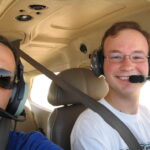
Welcome to the skies, where dreams of flight become a thrilling reality. Embarking on an airline pilot career is an adventure that does not always require a traditional four-year degree. Instead, a specialized pathway exists that can lead you to the captain’s seat. This journey is rigorous, demanding, and immensely rewarding. Let’s explore the steps you’ll take to spread your wings.
Key Takeaways: Article-at-a-Glance
- Discover the process of becoming an airline pilot without a traditional college degree.
- Learn about the essential steps starting with obtaining a Private Pilot License (PPL).
- Understand the importance of choosing the right flight school for your training.
- Get tips on how to prepare for the FAA written exam, a critical step in your pilot training.
- Gain insight into the subsequent ratings and experience needed to advance your flying career.
Step 1: Obtain Your Private Pilot License (PPL)
The first step to becoming an airline pilot without a degree is to get your Private Pilot License (PPL). This is your entry ticket into the world of aviation. It allows you to fly single-engine aircraft and carry passengers, although not for compensation or hire.
Understanding the PPL Requirements
To earn your PPL, you’ll need to meet certain prerequisites:
- Be at least 17 years old.
- Have a minimum of 40 flight hours, including 20 hours with an instructor and 10 hours of solo flights.
- Pass a third-class medical exam to ensure you’re fit to fly.
- Successfully complete a written knowledge test to prove your understanding of aviation concepts.
- Demonstrate your flying skills during a practical flight test with an FAA examiner.
Most importantly, remember that these requirements are just the starting point. You’ll need to build upon this foundation with more advanced training and certifications to pursue a career as an airline pilot.
Selecting a Flight School
Choosing the right flight school is crucial. It’s where you’ll spend many hours learning and honing your skills. Here’s what to consider:
- Look for schools with a good reputation and experienced instructors.
- Consider the location and weather conditions, as they can affect your training schedule.
- Check if the school has a variety of aircraft and well-maintained facilities.
- Ask about the school’s pass rate for the FAA exams—it’s a good indicator of their training quality.
Don’t hesitate to visit the schools, meet the instructors, and ask questions. You want to ensure that you’re comfortable and confident in your choice because, after all, you’re investing in your future.
Preparing for the FAA Written Exam
The FAA written exam is a milestone in your pilot training. It covers a wide range of topics, including:
- Airspace rules and regulations
- Weather patterns and their impact on flight
- Aircraft operations and performance
- Navigation and flight planning
- Aerodynamics and aircraft systems
To prepare for the exam:
- Study diligently using FAA-approved materials and textbooks.
- Take practice tests to familiarize yourself with the format and types of questions.
- Join a study group or find a study partner to discuss and review material.
- Consider online courses or apps that offer interactive learning experiences.
Remember, the key to success is consistent study and practice. The more you immerse yourself in the material, the better prepared you’ll be for the exam and your future as a pilot.
With these steps in mind, you’re now on the runway to an exciting career in aviation. In the next sections, we’ll delve into the additional ratings and experience you’ll need to reach new heights. So, buckle up and prepare for takeoff—it’s time to chase your dreams above the clouds.
Step 2: Advance Towards Instrument and Commercial Ratings
After securing your PPL, it’s time to broaden your aviation skills. The instrument rating and the commercial pilot license are your next targets. These qualifications are essential for any pilot looking to fly professionally.
Instrument Rating: Navigating the Skies
An instrument rating is crucial because it certifies you to fly under Instrument Flight Rules (IFR). This means you can navigate the skies even when visibility is poor. Here’s how to get there:
- Accumulate at least 50 hours of cross-country flight time as a pilot in command.
- Log a minimum of 40 hours of actual or simulated instrument time.
- Complete a structured instrument training program with a certified instructor.
- Pass the FAA instrument rating knowledge test, followed by a practical exam.
With an instrument rating, you’re no longer limited by clear skies. It’s a game-changer that significantly enhances your employability and safety as a pilot.
Commercial Pilot License: Expanding Horizons
Obtaining a Commercial Pilot License (CPL) allows you to be compensated for your flying skills. The requirements are more demanding than the PPL, but the rewards are greater. To earn your CPL, you’ll need to:
- Be at least 18 years old and hold a valid instrument rating.
- Log at least 250 total flight hours, including specific conditions and maneuvers.
- Complete a commercial pilot training course at an FAA-approved school.
- Pass the commercial pilot knowledge test and a practical exam.
With a CPL, you can work for charter companies, as a flight instructor, or in many other exciting roles in aviation.
Step 3: Building Your Flight Experience
Flight experience is the currency of the aviation world. More hours mean more opportunities. Here’s how to build your flight time effectively:
Time-Building Strategies
There are several ways to accumulate the necessary flight hours:
- Become a Certified Flight Instructor (CFI) to teach others while earning hours.
- Seek employment that offers time in the air, such as banner towing or aerial surveying.
- Join a flying club to access more affordable flying hours through shared ownership or rental.
- Network with other pilots who might need a safety pilot or co-pilot for their flights.
Each hour logged brings you closer to your goal, so take advantage of every opportunity to fly.
Exploring Non-Degree Career Pathways
Even without a traditional degree, there are pathways to a successful pilot career:
- Regional airlines often hire pilots with a strong flying background but no degree.
- Corporate aviation is another avenue, where companies operate their own aircraft.
- Government agencies, such as law enforcement and fire services, also employ pilots.
These roles can provide valuable experience and a stepping stone to major airlines in the future. So, keep your options open and your ambitions high.
By following these steps, you’re not just learning to fly; you’re laying the groundwork for a robust aviation career. So, keep your eyes on the horizon and your hands steady on the controls—the sky is truly the limit.
Step 4: Earning Advanced Certifications
As you climb the aviation ladder, advanced certifications become your milestones. They’re not just proof of your skills; they’re essential for flying more complex aircraft and for certain types of pilot jobs.
Multi-Engine Rating: The Power of Two
Flying with one engine is an art, but mastering multiple engines is a necessity for most commercial pilots. A multi-engine rating allows you to operate aircraft with more than one engine, which is a step up in capability, complexity, and job opportunities. Here’s how to add this rating:
- Complete a multi-engine training program that includes both ground and flight training.
- Learn about the aerodynamics, systems, and performance differences in multi-engine aircraft.
- Accumulate the required flight time as specified by the FAA, which includes hours in multi-engine operations.
- Pass an additional practical test specifically for multi-engine aircraft.
Adding a multi-engine rating to your license opens up doors to flying larger, more sophisticated aircraft and is often a prerequisite for flying with airlines.
Airline Transport Pilot (ATP) Certificate: The Golden Ticket
The Airline Transport Pilot (ATP) certificate is the highest level of aircraft pilot certification. Sometimes referred to as the Ph.D. of flying, it’s what you need to become a captain on a commercial airliner. To qualify for the ATP certificate, you must:
- Be at least 23 years old.
- Have a minimum of 1,500 flight hours, including specific types of flying experience.
- Hold a commercial pilot license with an instrument rating.
- Pass a rigorous written exam covering a variety of advanced topics.
- Complete an ATP Certification Training Program (ATP CTP).
- Pass the ATP practical test, which includes demonstrating proficiency in a multi-engine airplane.
With an ATP certificate, you are considered fully qualified to operate as a pilot-in-command for an airline, and it significantly boosts your employability in the aviation industry.
Step 5: Navigate the Hiring Process
With your certifications in hand, it’s time to land a job. The hiring process in aviation is competitive, so it’s important to stand out as a candidate.
Resume and Interview Techniques for Aspiring Pilots
Your resume is your first impression. Make sure it’s clean, professional, and highlights your flying experience, certifications, and any other relevant skills. Tailor your resume for each application to align with the airline’s values and needs. When it comes to interviews, preparation is key:
- Research the airline and understand their culture and expectations.
- Practice common interview questions and develop clear, concise answers.
- Be ready to discuss your flight experience and decision-making processes.
- Demonstrate your commitment to safety and continuous learning.
Remember, airlines are not just looking for pilots with technical skills, but individuals who will represent their company well and contribute positively to their teams.
Choosing the Right Airline: Cargo, Charter or Regional
There are several paths to choose from when starting your airline career:
- Cargo Airlines: Flying for cargo carriers like FedEx or UPS can be lucrative and offer unique flying experiences.
- Charter Companies: Charter flying offers a more varied schedule and can provide opportunities to fly to different destinations.
- Regional Airlines: Often a stepping stone to major airlines, regional carriers can offer quicker upgrades to captain and more flight hours.
Consider the type of lifestyle you want, the routes you’d like to fly, and the growth opportunities each path offers. Each has its own set of benefits and challenges, so choose the one that aligns best with your career goals and personal preferences.
From your first solo flight to the day you wear the captain’s stripes, each step on this journey is about growth, learning, and passion for flying. The path to an airline pilot career without a traditional degree is a testament to dedication and hard work. So, keep your logbook updated, your knowledge sharp, and your eyes on the horizon. Your dream of becoming an airline pilot is within reach.
Step 6: Embark on the Journey
As you set your sights on the skies, remember that an airline pilot career without a traditional degree is a challenging yet achievable dream. It requires dedication, discipline, and a passion for flying. By following the steps outlined in this guide, you’re not just pursuing a job; you’re chasing a calling. The sky is your domain, and every flight is a testament to your commitment to soaring higher. So, strap in, take control, and prepare for a career that takes you above and beyond.






Leave a Reply